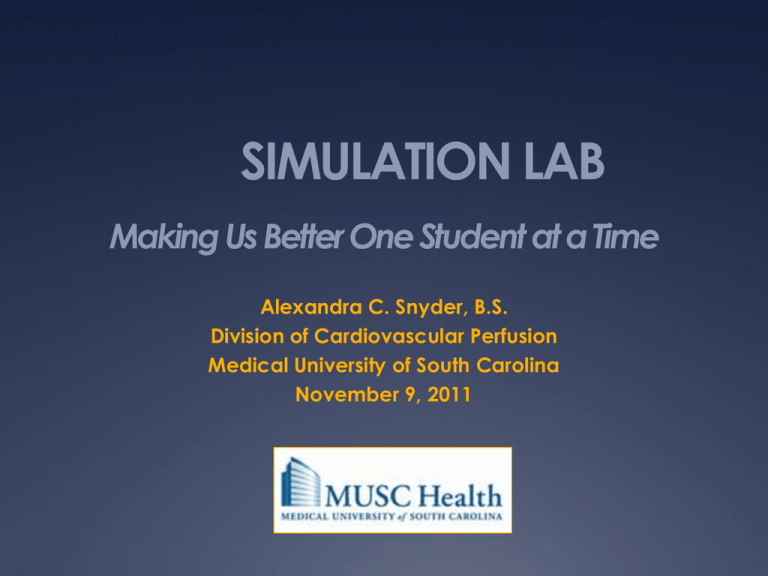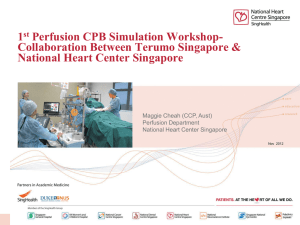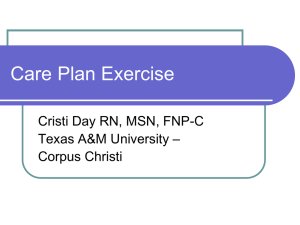Simulation Labs Making Us Better One Student at a Time
advertisement

SIMULATION LAB Making Us Better One Student at a Time Alexandra C. Snyder, B.S. Division of Cardiovascular Perfusion Medical University of South Carolina November 9, 2011 Disclosures I have nothing to disclose I have no relationship with commercial supporters Objectives To examine the use of simulation in other industries To examine the current role of simulation in perfusion To discuss the advantages of training students using simulation To consider what the future possibilities of perfusion simulation may be To present students’ perspectives of simulation in their perfusion education Simulation in Other Professions Routinely used in aviation, the nuclear industry, NASA & in many medical specialties Initial qualifications and beginning training Ongoing training and assessment/certification process Remedial training Add-on training for new techniques and skills Simulation in Perfusion No high-stakes assessment of competency using simulation is required by the ABCP for certification, recertification, or professional development Used primarily by perfusion schools and for research Investigation of human factors Few high-fidelity Orpheus perfusion simulators available worldwide* *ULCO Technologies, Sydney, NSW, Australia Traditional Perfusion Training Basic science background Academic instruction with some lab sessions and hands-on experience Clinical training as an apprenticeship process under supervision of an instructor “see one, do one, teach one” Perfusion SimulatorA New Paradigm in Student Learning Learn by Doing Orpheus Perfusion Simulator (Sim- Central Pty Ltd, Earlwood, New South Wales, Australia) Orpheus Perfusion Simulator “The easy to use, intuitive software allows the Perfusionist Trainer to control the simulator and execute the training session manually, or use a set of predefined scripts” http://www.ulcotechnologies.com/products/orpheus /orpheus.pdf “The fidelity of the physiologic monitoring is so realistic that our students will not be simulating bypass, they will be doing bypass on a simulated patient” -Bruce Searles Simulation-Based Curriculum Initial skill development Skill Refinement Performance Assessment Emergency Procedures SUNY Upstate’s Simulation Lab Routine Bypass Patient Emergencies Equipment Malfunctions Initiation of bypass Blood loss Aortic cannula obstruction Weaning from bypass LV dysfunction Oxygen supply failure Cooling/Rewarming Cardiac Arrhythmias Pump power supply failure Use of centrifugal pumps Failure of anticoagulation Heat exchanger failure Variations in patient resistance Air embolism Monitor failure Variations in patient coagulability Anaphylaxis Aortic cannula displacement Use of vasodilators/constrictors Protamine reaction Oxygenator failure Use of vasoconstrictors Transfusion reaction Venous air entrainment O2 consumption changes Blood gas abnormalities Circuit leaks Benefits of Simulation Training Improved performance of individuals Long-term maintenance of proficiency Provides a real-time, safe setting without harming patients Instructors can devise training scenarios that will test certain skills (“trigger events”) Coaching and Debriefing Improved patient safety Sim Lab vs. Operating Room Sim Lab Operating Room *Student-focused *Patient-focused -No room for mistakes *Reinforces lectures *Determined by random case for the day *Exposure to low volume, highrisk events frequently *Experience determined by cases *Can demonstrate corrective action *No re-dos *Unlimited experience *Limited case load *Clinical variety *Experience based on rotation and surgeon Future Applications Human factors training Interprofessional education CPB for MDs Continuing medical education Simulation-based competency test Recertification (Re-CCP) Rehearse new procedures & devices Product development Patient Safety Research Barriers to Simulation in Perfusion Limited number of high fidelity perfusion simulation centers Lack of validated & standardized evaluation instruments Lack of trained simulation facilitators Lack of agreed standards for simulation-based education Lack of simulators used for training in pediatric perfusion The Student Perspective Fernandez A. Simulation in perfusion: where do we go from here?. Perfusion. 2010;25(1):17-20. The Student Perspective Thought simulation was beneficial prior to doing clinical work Thought that the simulator was a good alternative to doing a clinical case Thought that simulation should be used from the first day of class through graduation Want more simulation! Conclusions Simulation is commonly used to train professionals in equally risky industries to improve critical skills and patient safety Implementation of simulation into perfusion training is currently in its infancy, but is proving worthwhile This modality has been used in the academic setting to develop basic perfusion skills, gain experience, and practice emergency procedures There is a role for simulation in the future of perfusion beyond academics Student opinion supports full integration of simulation training into their perfusion education Acknowledgements Ashley Hodge, MBA, BS, FPP, CPP Joseph J. Sistino, CCP, MS, MPA Adam Fernandez, MPS, CCP Nicole Michaud, MSP, CCP Medical University of South Carolina Division of Cardiovascular Perfusion The American Society of Extracorporeal Technology References Fernandez A. Simulation in perfusion: where do we go from here?. Perfusion. 2010;25(1):17-20. Issenberg SB, McGaghie WC, Hart IR, et al. Simulation technology for health care professional skills training and assessment. JAMA. 1999;282(9):861-866. Ray RN. Simulation: its application in the nuclear power industry. Proc Indian Acad Sci C1(4):345-59. Gaba DM. The future vision of simulation in health care. Qual Saf Health Care. 2004;13(Suppl 1):i2-i10. Sorensen B, Crane P. Cardiopulmonary bypass simulation training adapted from air force flight simulation. Sistino JJ, Michaud NM, Sievert AN, Shackelford AG. Incorporating high fidelity simulation into perfusion education. Perfusion. 2011;26(5):390-394. SUNY Upstate Medical University. "Upstate Leads Internationally in Perfusion Simulation Training." SUNY Upstate Medical University. Web. 01 Nov. 2011. <http://www.upstate.edu/chpalumni/>. References Darling E, Searles B. Oxygenator change-out times: the value of a written protocol and simulation exercises. Perfusion. 2010;25(3):141-143. Palanzo DA. Perfusion safety: defining the problem. Perfusion. 2005;20(4):195-203. Morris RW, Pybus DA. “Orpheus” cardiopulmonary bypass simulation system. J Extra Corpor Technol. 2007;39(4):228-233. Ninomiya S, Tokaji M, Tokumine A, Kurosaki T. Virtual patient simulator for the perfusion resource management drill. J Extra Corpor Technol. 2009;41(4):206-212. Ninomiya S, Tokumine A, Yasuda T, Tomizawa Y. Development of an educational simulator system, ECCSIM-Lite, for the acquisition of basic perfusion techniques and evaluation. J Artif Organs. 2007;10(4):201-205. Merry A. Human factors and the cardiac surgical team: a role for simulation. J Extra Corpor Technol. 2007;39:264-266. Turkman A, Rosinki D, Noyes N. A simulator for perfusion training. Perfusion. 2007;22:397-400 Thank you for your time






